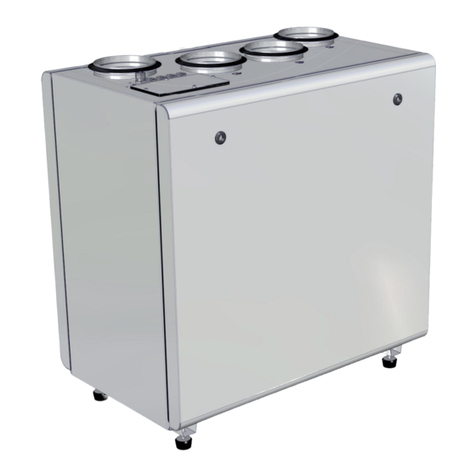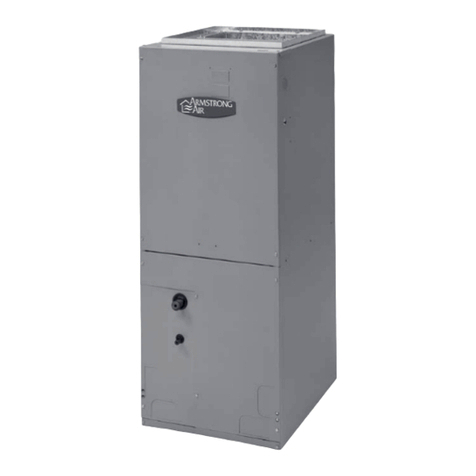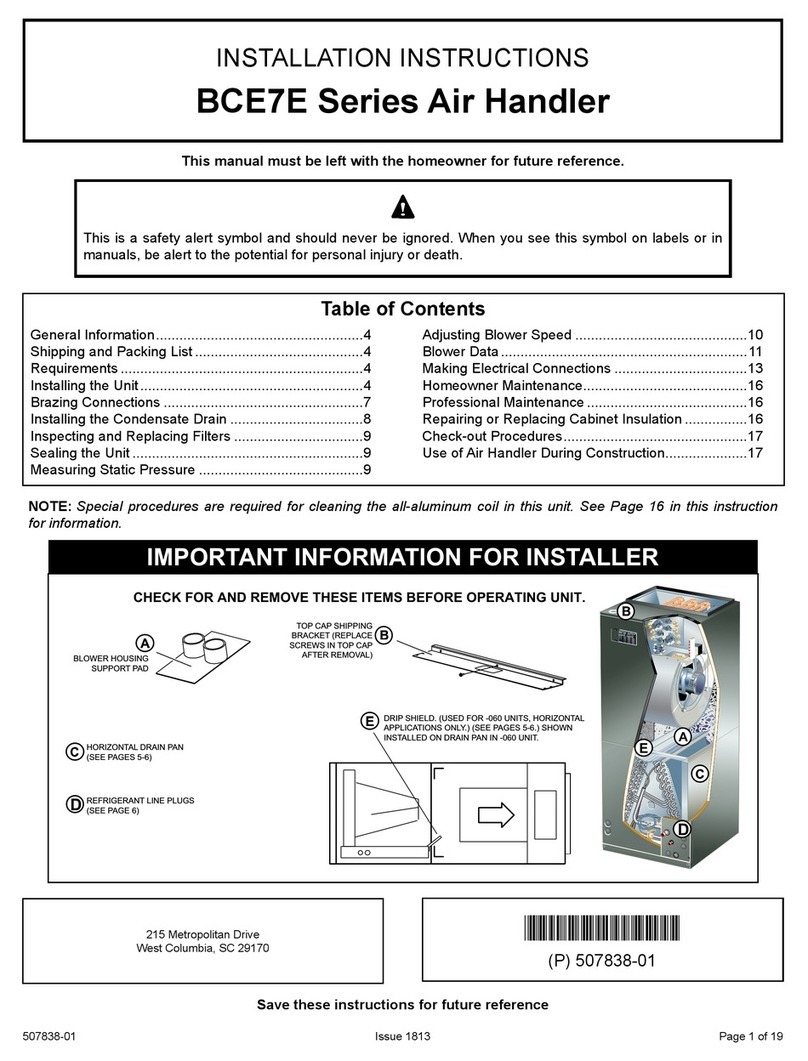
507746-01Issue 1821Page 8 of 39
Use the following procedures to congure the unit for
horizontal left-hand discharge operations:
1. Pull the coil assembly from unit. Pull off the horizontal
drain pan.
2. Remove the drain plugs from back drain holes on
horizontal drain pan and reinstall them on front holes.
After removal of drain pan plug(s), check drain hole(s)
to verify that drain opening is fully open and free of any
debris. Also check to make sure that no debris has
fallen into the drain pan during installation that may plug
up the drain opening.
IMPORTANT
3. Rotate drain pan 180º front-to-back and install it on the
opposite side of the coil.
4. Remove screws from top cap. Remove horizontal drip
shield screw located in the center of the back coil end
seal as illustrated in Detail A in Figure 4.
5. Rotate horizontal drip shield 180º front-to-back.
6. Remove plastic plug from left hole on coil front end seal
and reinstall plug in back hole. Reinstall horizontal drip
shield screw in front coil end seal. Drip shield should
drain downward into horizontal drain pan inside coil.
NOTE: Be very careful when reinstalling the screws
into the coil end plate engaging holes. Misaligned
screws may damage the coil.
7. From the upow position, ip cabinet 90º to the left
and set into place. Replace blower assembly. Secure
coil in place by bending down the tab on the cabinet
support rail as illustrated in Figure 4 and Figure 5.
HORIZONTAL DRIP SHIELD (BCE7S60 MODEL)
DOWN-FLOW RAIL FRONT EDGE OF HORIZONTAL
DRAIN PAN
Figure 5. Left-Hand Discharge Conguration
8. Install the horizontal shield (BCE7S60 model) on the
front edge of the horizontal drain pan as illustrated in
Figure 5.
NOTE: For horizontal applications in high humidity
areas, remove the downow rail closest to the drain
pan. To remove rail, remove screw from rail at back
of unit and at cabinet support rail. Remove downow
rail then replace screws. Also, seal around the exiting
drain pipe, liquid and suction lines to prevent inltration
of humid air.
9. Knock out drain seal plate from access door. Secure
plate to cabinet front ange with screw provided.
10. Flip access door and replace it on the unit.
11. Set unit so that it is sloped 1/4ʺ toward the drain pan
end of the unit. Connect return and supply air plenums
as required using sheet metal screws.
12. If suspending the unit, it must be supported along the
entire length of the cabinet. If using chain or strap,
use a piece of angle iron or sheet metal attached to
the unit (either above or below) so that the full length
of the cabinet is supported. Use securing screws no
longer than 1/2ʺ to avoid damage to coil or lter, as
illustrated in Figure 3. Connect return and supply air
plenums as required using sheet metal screws.
Downow Application
Use the following procedures to congure the unit for
downow operations:
If electric heat sections with circuit breakers is applied
to downow BCE7S unit, the circuit breakers must
be rotated 180° to the UP position. See electric heat
installation instructions for more details.
IMPORTANT
Table 3 outlines the sizes of the various drip shields.
NOTE: (BCE7S60 Model Only) Remove access panels
and horizontal drip shield from the corrugated padding
between the blower and coil assembly.
1. Remove the coil assembly from the unit.
2. For best efciency and air ow, remove the horizontal
drain pan from the units in downow positions as
illustrated in Figure 6.
3. Rotate cabinet 180º from the upright position. See
Figure 6. You may need to rst remove the blower
assembly to lighten the cabinet for lifting.
4. Foam tape that is provided creates a seal between the
drip shield and the coil so that water does not leak into
the air stream. The foam tape pieces are precut. Apply
the tape to the drip shields as illustrated in Figure 7
and specied as follows:
• Apply two pieces of foam tape provided down both
ends of each shield. The tape should measure
4-3/4ʺ X 2ʺ (120 X 25 mm). Ensure that the tape
covers both sides of the shield equally.
• Apply the longer piece of 1 inch wide foam tape
between the end pieces of tape.
5. From the underside of the coil, install the downow
drip shield rmly in place as illustrated in Figure 8.































